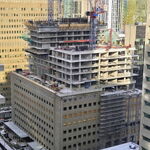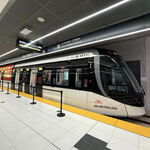Northern Light
Superstar
@DSC noted over in the John Tory thread that TO Inview had been updated (the City's infrastructure project mapping plan) to show projects that are planned for 2023 or to start in same.
There's some exciting, ambitious stuff there from the Cycling unit.......whether it all happens remains to be seen.
I'm not going to suggest the list below is comprehensive, but a few highlights.
Multi-use Trails/Paths
1) As I noted over in the Golf Course thread, the City is set to redesign Dentonia Golf Course to include a multi-use trail. They already have the project in TO Inview as 2023-2024
2) The Mid-Humber Gap is listed as 2023-2025
3) The N-S section (western leg- of the Finch Hydro Corridor from Beth Ridge to the West Humber Trail
4) Warden Hydro Corridor (entire length, from Meadoway to Maryvale (south of 401)
On Road
1) Bloor west to Royal York - 2023
2) Victoria Park Avenue from St. Clair to the Gatineau Trail (Meadoway); as well as Donside to Danforth
3) The return of Bike lanes/infra to Brimley
4) Some type of enhanced cycling facilities on Bay from Dundas to Wellesley
5) Bellamy from just north of Eglinton to Progress
* 6) Trail, but roadside along Ellesmere from Orton Park to Morningside
7) Warden Avenue from Lupin (just south of 401) to Finch Hydro Corridor
8) Steeles from Brimley to McCowan
9) Scarborough Golf Club Road, Lawrence to Kingston Rd.
10) Don Mills Road - York Mills to Graydon Hall , and another section just north of 401
Honestly if 1/2 of this gets done I'd be extremely pleased; if they get all of it, that's outstanding.
Not a finished cycling vision for the City but remarkable progress.
There's some exciting, ambitious stuff there from the Cycling unit.......whether it all happens remains to be seen.
I'm not going to suggest the list below is comprehensive, but a few highlights.
Multi-use Trails/Paths
1) As I noted over in the Golf Course thread, the City is set to redesign Dentonia Golf Course to include a multi-use trail. They already have the project in TO Inview as 2023-2024
2) The Mid-Humber Gap is listed as 2023-2025
3) The N-S section (western leg- of the Finch Hydro Corridor from Beth Ridge to the West Humber Trail
4) Warden Hydro Corridor (entire length, from Meadoway to Maryvale (south of 401)
On Road
1) Bloor west to Royal York - 2023
2) Victoria Park Avenue from St. Clair to the Gatineau Trail (Meadoway); as well as Donside to Danforth
3) The return of Bike lanes/infra to Brimley
4) Some type of enhanced cycling facilities on Bay from Dundas to Wellesley
5) Bellamy from just north of Eglinton to Progress
* 6) Trail, but roadside along Ellesmere from Orton Park to Morningside
7) Warden Avenue from Lupin (just south of 401) to Finch Hydro Corridor
8) Steeles from Brimley to McCowan
9) Scarborough Golf Club Road, Lawrence to Kingston Rd.
10) Don Mills Road - York Mills to Graydon Hall , and another section just north of 401
Honestly if 1/2 of this gets done I'd be extremely pleased; if they get all of it, that's outstanding.
Not a finished cycling vision for the City but remarkable progress.
Last edited:





